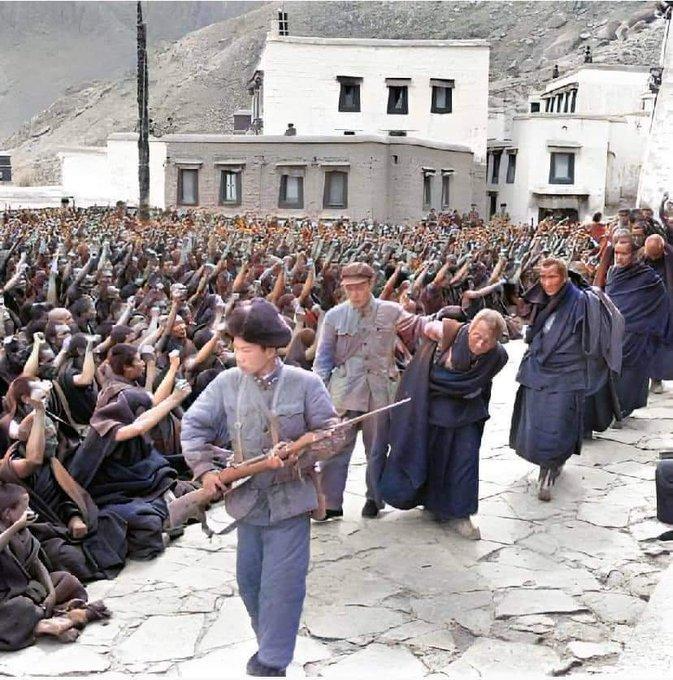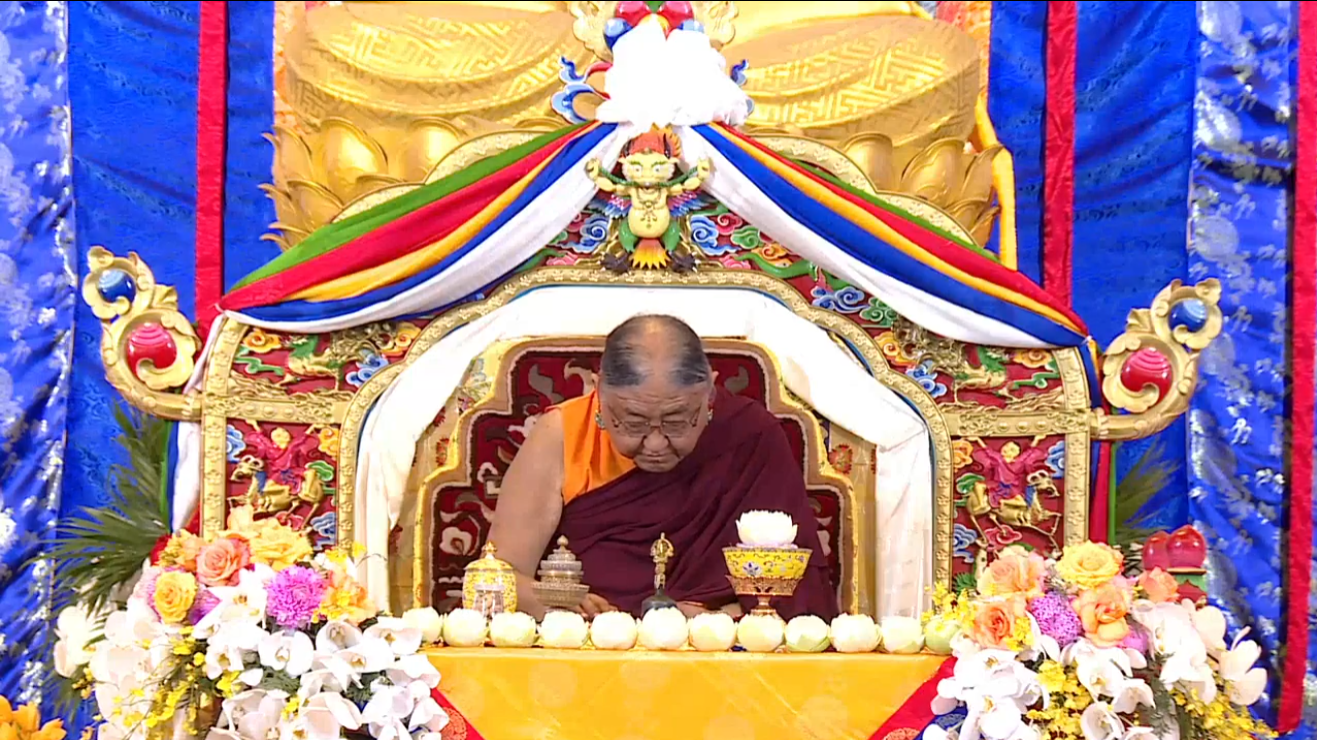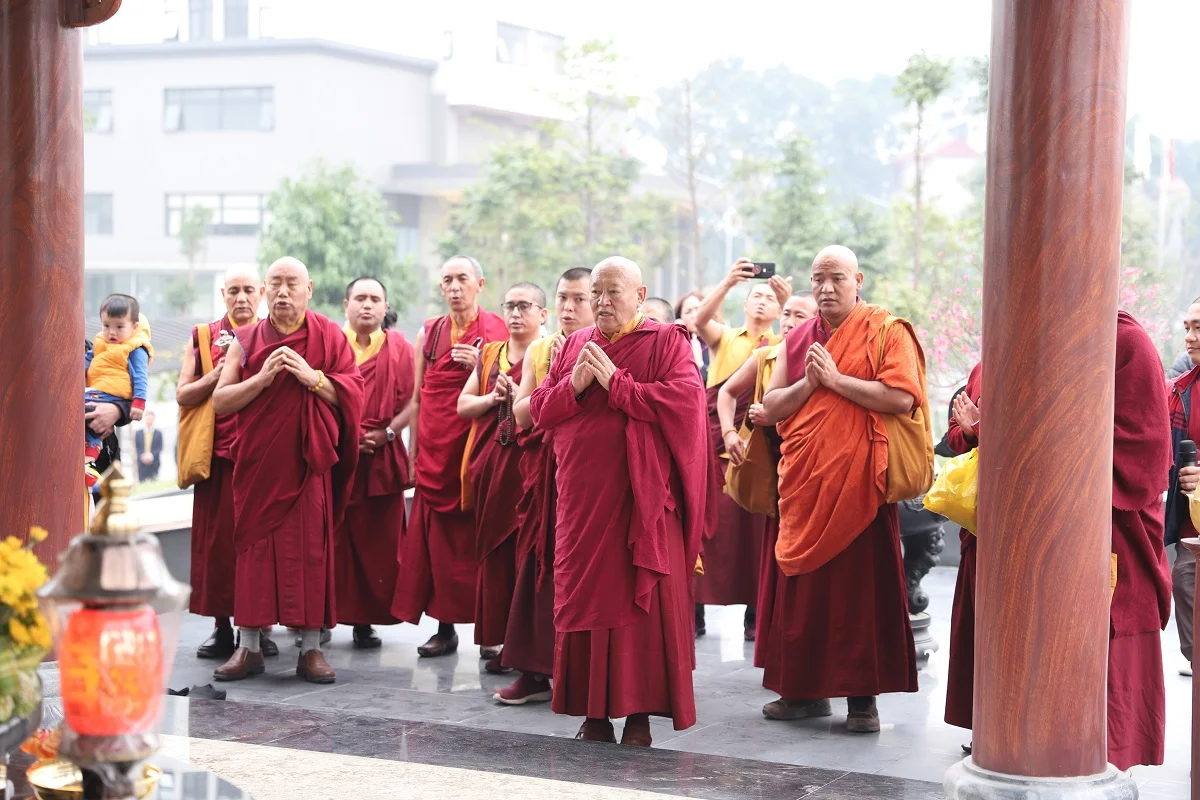Job Vacancy: Editorial Assistant for The Vietnamese Magazine
The Vietnamese Magazine—an English-language publication by Legal Initiatives for Vietnam dedicated to raising international awareness of Vietnam’s political

This article was published in Luat Khoa Magazine on May 24, 2023. Lee Nguyen translated this into English.
A renowned exiled figure from Tibet, second only to the Dalai Lama, recently arrived in Vietnam.
This spiritual figure is Gongma Trichen Rinpoche. At 77 years old, he is the 41st successor of the Sakya sect, one of the four major traditions of Tibetan Buddhism, also known as Vajrayana. During his visit, he and his disciples organized numerous events, including precept instruction ceremonies, for many Buddhist practitioners.
The Sakya sect and other Tibetan Buddhist traditions, such as Drikung Kagyu and Drukpa Kagyu, frequently organize official visits to Vietnam.
A vast spiritual tourism area following the Drikung Kagyu tradition has recently been inaugurated in Lam Dong Province, alongside a series of pagodas and meditation centers of Tibetan Buddhism in many provinces and cities throughout the country.
The growing occurrence of these events suggests that Tibetan Buddhism and various Vajrayana traditions have been fortifying their presence in Vietnam. However, the question remains: What factors have contributed to their permission to establish and expand in the country?
Promoting the Vajrayana sect in Vietnam and other countries is connected to the painful history of Tibet.
In Tibet, Buddhism completely dominates the lives of the people. Tibetans believe that the monks are the embodiment of the Buddha. Therefore, the monks are seen as living Buddhas with great authority who engage in religious activities and hold governing power over the country. As such, the Dalai Lama is regarded as the king, the spiritual leader, and the head of the Tibetan region.
In 1949, the victory of the Chinese Communist Party over the Kuomintang marked the beginning of a great tragedy for Tibet. After proclaiming the establishment of the People's Republic of China, Mao Zedong sent troops to invade Tibet in 1950. At that time, the Dalai Lama was only 15 years old.

From 1951 to 1959, there were some migrations out of Tibet, but these numbers were relatively small and primarily consisted of business people who feared the war's impact.
On March 10, 1959, in response to the Chinese army's presence, the Tibetan people orchestrated an uprising, calling for self-rule and seeking to safeguard the Dalai Lama against the Chinese military. Tragically, numerous lives were lost during the subsequent crackdown. Eventually, at the end of March, the Dalai Lama escaped across the border into India, securing safety.
Immediately after the Dalai Lama left his home country, thousands of Tibetans crossed the border to follow him. Additionally, many went to Nepal and Bhutan.
Initially, the Indian government facilitated the reception of Tibetan refugees. Those who arrived in India between 1959 and 1979 were granted documents allowing them to stay in India and to use these documents for international travel and re-entry to India.
Gongma Trichen Rinpoche, the leader of the Sakya sect, who recently conducted religious teachings in Vietnam, also crossed the border into India in 1959.
Regrettably, Tibetan monks never had a stable life in India.
Immediately upon arriving in India, the Dalai Lama established a democratic framework for the Tibetan exile community.
He founded the Tibetan Government-in-Exile, which includes representatives from various sects and regions of Tibet. The establishment of the Tibetan administrative system in India contributed to the welfare of the exiles and organized nonviolent activities aimed at regaining independence for their home country.
Nevertheless, exiled Tibetans were not recognized as refugees in India because the government had not signed the United Nations Convention Relating to the Status of Refugees. Additionally, India does not want to antagonize China, so it does not have appropriate residency policies for Tibetans.
Tibetans in India presently live in a precarious legal situation. Likewise, they face difficulties finding employment, buying homes, accessing bank credit, and even being accepted by some universities. Their residency policies can be changed anytime, putting tremendous pressure on Tibetan monks.
In 2011, there were around 150,000 Tibetan refugees in India, but by 2018, this number had decreased to approximately 85,000, a 44% decline, according to Indian statistics. Many have chosen to settle in Canada, the United States, Switzerland, Germany, and dozens of other countries.
Another reason Tibetan monks establish centers abroad is to attract followers and amass resources for their sects.
The sects experienced a decline upon leaving Tibet. India is also not a country with a large population of Buddhist followers. Expanding their activities to other foreign countries is necessary, and the Vajrayana sect now encompasses Tibetan practitioners and followers from many countries worldwide.
In addition to funding religious activities, Tibetan monks have expanded their scope of operations and taken opportunities to engage in diplomatic activities to condemn China, thus forming a solid international network. The Tibetan exile community is one of the most successful advocacy communities maintaining long-term support from many international organizations.
Many centuries ago, the Vajrayana tradition had some influence on Vietnamese Buddhism. However, the influence of Vajrayana Buddhism remains minimal. It was not until 1936 that a Vietnamese monk was said to have received the Buddhist precepts directly from a Tibetan monk, but no tradition was established in Vietnam.

Until the early 2000s, no Tibetan monks had visited Vietnam to spread their traditions and establish a religious foothold.
In 2007, the Vietnamese government allowed the head of the Drukpa Kagyu lineage, Gyalwang Drukpa, to visit Huong Pagoda. He continued to visit Vietnam in 2008, 2010, 2011, 2013, 2014, and 2015.
In 2016, when the Tay Thien Pagoda appointed its abbot, he attended the appointment ceremony there. Tay Thien Pagoda is a Vajrayana pagoda of the Vietnam Buddhist Sangha. He appeared in Vietnam's forums, grand ceremonies, and Buddhist events in the following three consecutive years, 2017, 2018, and 2019. It was not until four years later, in 2023, that he returned to Vietnam again after the COVID-19 pandemic.
In 2010, a prominent Tibetan exiled monk from the Drikung Kagyu lineage officially visited several Vietnamese monks. In 2015 and 2016, Drikung Kyabgön Chetsang, the head of this sect of Tibetan Buddhism, came to Vietnam to organize various ceremonies. He continued to visit Vietnam in 2017, 2018, 2019, and 2022. In March 2023, he performed the inauguration ceremony for a spiritual tourism site in Lam Dong Province.
The Sakya lineage is the latest Tibetan Buddhist sect to enter Vietnam. It began in 2017, but the sect’s activities were interrupted until its return in 2023. During the sect’s absence, Vietnamese monks still regularly conducted religious activities following this tradition at the meditation center in District 7 and at a pagoda of this tradition in Cu Chi District, Ho Chi Minh City.
It can be observed that some Tibetan Buddhist lineages have appeared regularly in Vietnam in recent years. Some have even established multiple meditation centers and pagodas in Vietnam.
The government has permitted the presence of Tibetan monks in all their visits to Vietnam. Even the Vietnam Buddhist Sangha lends them pagodas to perform their rituals for some religious events. Some people believe that Vietnam tolerates the presence of Tibetan monks to demonstrate the country’s acceptance of religious freedom to the international community.

This perception may not be entirely wrong, as many countries in Asia allow Tibetan monks to operate within their borders. However, there may be other reasons as well. Among them is the belief that Tibetan Buddhism may be suitable for the spiritual needs of a particular portion of the Vietnamese population right now.
Vajrayana is a mystic and esoteric branch of Buddhism. Vajrayana, or Diamond Vehicle, emphasizes soul cultivation to achieve rapid spiritual enlightenment. This particular branch has gained renown for its utilization of mystical techniques involving mantras, mudras (hand gestures), the practice of Mandala (a symbolic configuration in spiritual traditions), and similar practices.
On the other hand, according to the Tibetan tradition, Tibetan monks, especially the heads of sects, are considered the embodiment of Buddhas.
These two explanations also can be found in many new religious movements today, many of which come to Vietnam from foreign countries. These new religions have leaders who often claim to be the incarnation of Buddha or God and offer teachings while behaving as supreme and sacred beings. This form of religion meets the needs of many people.
Another reason is that Vietnamese Buddhism, led by monks of the Vietnam Buddhist Sangha, is losing credibility, especially as it has become involved in money and politics while gradually moving away from its original teachings or fundamental Dharma. The timely appearance of overseas monks brings a new spirit of propagating the Dharma. Furthermore, promoting Tibetan Buddhism in Vietnam is safer for the government as the state can use the monks of the country’s official Buddhist organization to control and monitor Tibetan monks.
However, we must also acknowledge that Vietnam is witnessing the operation of numerous new religious movements, which the government sees as a significant political challenge. Therefore, inviting Tibetan monks to Vietnam is a rare exception to state policy.
Until now, the Gelug tradition, the branch of Buddhism associated with the Dalai Lama, has not officially appeared in Vietnam. This is most likely due to the government wanting to avoid further diplomatic issues with China.
Nevertheless, the religious activities of Vajrayana are promoted to a limited extent in Vietnam, indicating a certain level of tolerance. For example, the 41st Sakya Trizin, a prominent Tibetan exile figure, visited Vietnam for two weeks, but there was no coverage by the state media. If there was coverage, the press usually referred to these monks as Indian or Bhutanese monks rather than directly mentioning that they were Tibetan exiles.
Furthermore, the appearance of Tibetan monks in Vietnam seems more ceremonial, as these delegations are only allowed to conduct purely religious activities within a limited time frame. They are not allowed to stay in Vietnam or manage their centers or pagodas; they must rely on Vietnamese monks.
The story of the Vajrayana Buddhist sects officially coming to Vietnam involves the participation of businesspeople and some government officials who are initially driven by individual spiritual needs and a desire to promote these Buddhist traditions quickly.
However, regardless of circumstances, religious activities in Vietnam will continue to face challenges in gaining significant influence without substantial support from wealthy and influential Buddhist followers, even when they have support from the government.
Vietnam's independent news and analyses, right in your inbox.